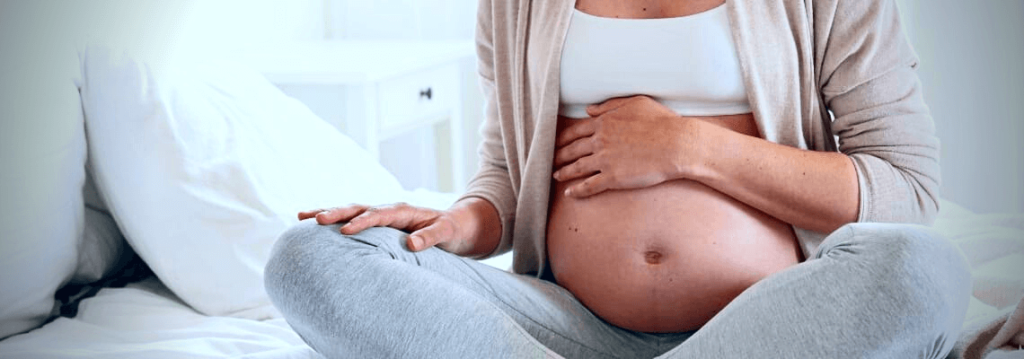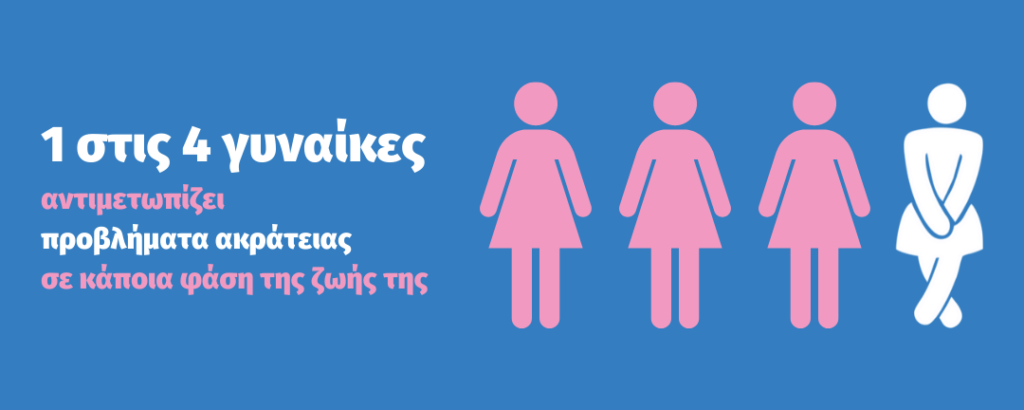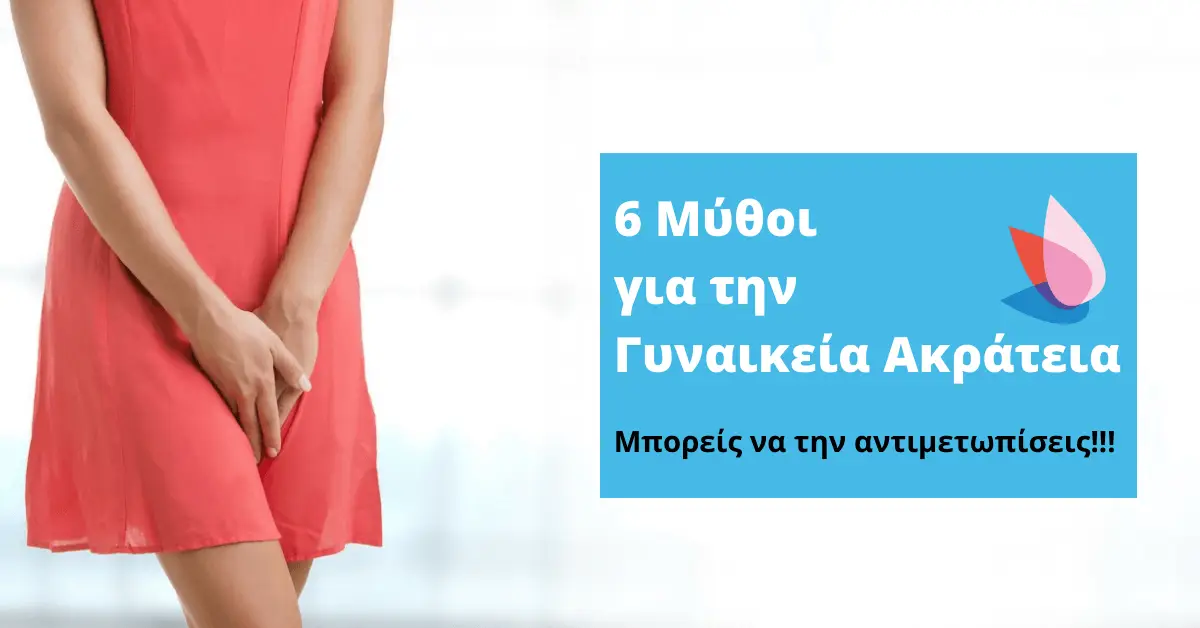Unfortunately, many women have been influenced by long-held myths about urinary incontinence and have accepted that the only way to continue their lives as normally as possible is to wear diapers and pads… or to be within a stone’s throw of a toilet 24/7. In reality, this doesn’t have to be your everyday life and we’re going to try to uncover the top misconceptions about the common problem of female urinary incontinence that almost 50% of women will face at some point in their lives .
1. Incontinence is “normal” as we age
This is the most popular myth about urinary incontinence and in fact, most women believe that it is an inevitable symptom of aging since our bodies simply lose the ability to hold urine. As women approach menopause, estrogen levels decrease and because this is the hormone that keeps the bladder and urethra healthy, less estrogen causes weakness in the pelvic floor muscles.
Menopause is indeed a contributing factor to the onset or worsening of incontinence, but it is not the only one. Just take a look at the causes and underlying diseases that have been shown to cause incontinence:
- Normal or invasive childbirth
- Genital relaxation
- Menopause
- Neurological diseases
- Spinal and pelvic injuries and trauma
- Inflammations and urinary tract infections
- Obesity
- Smoking
- Physical activity level
- Medications (e.g. steroids and diuretics)
- Genital surgeries (e.g. hysterectomy)
- Heart failure
- Chronic renal failure
- Diabetes
- Chronic obstructive pulmonary disease
- General cognitive dysfunction
- Sleep disorders
- Depression
- Metabolic syndrome
- Diet

Looking at the literature, from 1997 to the present, there is significant evidence supporting the theory that the occurrence of urinary incontinence increases with age:
- 20% – 30% in young women (18 – 35 years old)
- 30% – 40% in middle-aged women (36 – 55 years old)
- up to 50% in older women (over 56 years old)
But there are differing opinions about the pattern of this increase. For example, teenagers and young women who participate in sports have been found to have higher rates than expected in several studies. According to Pamela Moalli, MD , a professor of urogynecology at the University of Pittsburgh Magee-Womens Research Institute, incontinence problems are commonly associated with sports injuries, with about 20 percent of female college athletes reporting leaks during their sports activities. These are usually sports that can damage the pelvic muscles and connective tissue that support the bladder.
Urinary incontinence has been defined in the joint report of the International Continence Society as the involuntary leakage of urine. However, many researchers choose to relate prevalence according to the frequency of involuntary leakage of urine but on a daily, weekly, monthly or annual basis. For this and other reasons, it is still extremely difficult to compare the results of different population studies.
And since incontinence is one of the main reasons why an elderly lady will end up in a nursing home, let's agree that aging can increase the likelihood, but it is not something predetermined and most of the time it can be treated effectively.
Regardless of age, most women don't tell their doctor that they have incontinence problems because they're embarrassed or simply believe it's something "normal" and inevitable. It's not .
Advanced age is one of the major risk factors for incontinence, but NO, it is not normal.
Uduak U. Andy , MD – Assistant Professor of Obstetrics and Gynecology at the Hospital of the University of Pennsylvania
Just think about how much our culture has changed in the last few decades about the way we view old age. The stereotype of the old lady sitting in an armchair knitting is no longer true to modern reality. The elderly, who theoretically only start at 56, now enjoy everything life has to offer the younger generation without any concessions.
2. Incontinence is “normal” during and after pregnancy

During pregnancy women may be more prone to leakage at certain times as the growing uterus changes the angle of the urethra (normally of course the body should be able to support the urethra and prevent leakage). After having a baby, it may be normal to have some leakage in the first few weeks (depending on the delivery), but then, it should improve and stop.
Many women believe that pregnancy is the source of all evil and that the “damage” caused to the pelvic area is normal and will cause incontinence… for the rest of their lives. Of course, some women experience intermittent problems, but this is nothing more than an annoying condition that will last no more than 6 weeks. Continuing incontinence after pregnancy is over is not at all normal but a medical problem that is highly likely to be due to some other factor and can be treated .
3. The only solution is diapers and incontinence pads
In complete agreement with the two previous myths, very often, women assume that there are no treatment options available for urinary incontinence other than pads or diapers and because of this misconception they do not visit a doctor. Of course, pads and diapers are one of the ways to treat female incontinence , possibly the most popular, but they are certainly not the best possible solution. In fact , they are simply an aid that often creates more problems than they are intended to solve .

According to the World Health Organization, more than 200 million people worldwide experience incontinence problems , and while many alternatives are available to help them effectively manage their condition, 70% do not seek help and are limited to incontinence pads .
Unfortunately, however, most do not wear the right diaper, with the right absorbency, and this is a mistake that can lead to serious health problems such as:
- Loss of skin integrity
- Urinary tract infections
- Dermatitis
And because in many cases we are not dealing with elderly women who are bedridden, there are significant psychological impacts such as:
- Limited social activities
- Low self-esteem
- Decreased sense of well-being
- Depression
- Isolation
On the contrary, a proper female urinary incontinence product can help you manage the condition and continue your life as before without complications. A very good example is a special diaphragm, a small silicone ring-shaped device that “pushes” against the wall of the vagina and urethra to support the muscles of the pelvic area and help reduce stress incontinence . These intravaginal devices come in different sizes and it is always preferable to choose disposable products to eliminate the risk of urinary tract infections.
4. Only surgery treats incontinence
At the complete opposite extreme, many women assume that only an invasive treatment, a surgery, is the only way to address the problem completely. The truth is that some doctors don't always realize that there are many things that can be done beyond surgery or medication.
Urinary incontinence is mainly caused by damage to two organs, the urethral sphincter that controls the flow of urine and the bladder. There are about 300 different surgical options for the treatment of urinary incontinence , but the difficulty is choosing the surgery that will have the best chance of working well for the woman in the long term, as it can create problems such as difficulty urinating, worsening incontinence or simply fail to solve the problem. Surgical techniques are usually oriented towards treating sphincter damage, either by placing a free tension vaginal band TVT – TVTO – TOT (which is usually the ultimate choice of urologists) or in severe cases by placing an artificial hydraulic sphincter , which opens and closes at will like a natural one.
Beyond that, there are non-invasive treatment options for urinary incontinence that don't involve a pad or diaper:
- Intravaginal rings
They are inserted into the vagina like a tampon to help support the pelvic organs. They are less risky than surgery and when properly selected, they are comfortable to use with unique results while eliminating the risk of urinary tract infections and other complications. - Kegel exercises
Pelvic floor muscle training can be a great way to regain control. Also known as pelvic floor muscle training (PFMT) , it has been shown to be an effective treatment for urinary incontinence symptoms. However, it is extremely important to do the exercises daily and correctly. A physical therapist who specializes in this area can assess your condition and tailor a program to meet your needs. - Bladder training
Formerly known as bladder discipline or retraining, it is a training program that is accompanied by a specific urination schedule with gradually adjusted intervals between urinations, thus gradually extending the time between successive visits to the toilet. - Dietary modifications
Some changes to your daily diet can reduce the incidence of unwanted leaks. It is usually recommended to avoid caffeine, alcohol, artificial sweeteners, acidic foods, and in general anything that can irritate the bladder or make it overactive .It is understood that reducing fluid intake is a strategy that is often used to relieve the symptoms of incontinence, but it would be better to consult a health professional to ensure that daily fluid intake is sufficient to avoid thirst but especially dehydration. - Drug treatment
Antimuscarinic (anticholinergic) drugs are indicated for the treatment of urge urinary incontinence . Although they have a response rate of approximately 70% in patients, treatment is often limited due to several undesirable side effects . Dry mouth is the main side effect, but other more serious side effects such as constipation, blurred vision, fatigue, and cognitive dysfunction may also occur. - Quitting smoking
In all studies, smoking appears to be associated with urinary urgency and stress urinary incontinence. - Weight loss
Excess weight has been identified as a risk factor for urinary incontinence in most epidemiological studies, and the proportion of those undergoing surgery for incontinence who are overweight or obese is higher than in the general population. Most of the available evidence relates to women anyway. Three systematic reviews and two large randomized trials concluded that weight loss was beneficial, and five more randomized trials show a similar beneficial effect on incontinence after weight loss surgery.
5. You should always be ready to “run” to the toilet
Many women with incontinence think that if you can get to the bathroom in time, everything is fine. You won't always be able to do that, and most of the time it's virtually impossible unless you're already near a toilet. If you've tried this tactic, you know that it's not very reliable and carries an even greater risk of injury.
The next time you feel that irresistible urge, don't run. Just stop, take a good deep breath, and do a strong Kegel exercise to tighten your pelvic floor muscles and, by extension, your bladder. Then, you can simply walk to the bathroom .
6. My doctor can't help me deal with incontinence
I don't need to point out that this statement is completely false and dangerous. Certainly, apart from ignorance, fear of treatment, shame, and the excuse of normal, many women simply don't know where to turn. Should they see a primary care doctor? A gynecologist? A urologist?
Of course, all of these can help, but the scientific community has only recently realized the magnitude of the problem and created a new specialty, urogynecology . The reason many women don't know about this unique specialty is because urogynecology is a relatively new field. According to the American Urogynecological Association , doctors only began receiving certification in 2013.

The goal of this subspecialty of gynecology and obstetrics is to provide a high level of specialized diagnostic and therapeutic approach to women with complex pelvic floor disorders such as urinary incontinence, overactive bladder symptoms, relaxation of pelvic organs such as the uterus or vaginal walls, and urination disorders.
The urogynecologist handles everything from diagnosis and evaluation of the condition to management and of course, treatment . The means they choose to treat incontinence are as usual:
- Behavioral therapy
- Intravaginal devices
- Drug treatment
- Surgery (as a last resort if the previous ones fail)
The important thing to remember is that incontinence doesn't have to be a way of life.With time, information, and appropriate intervention from specialist doctors, urinary incontinence can be treated with complete success .


